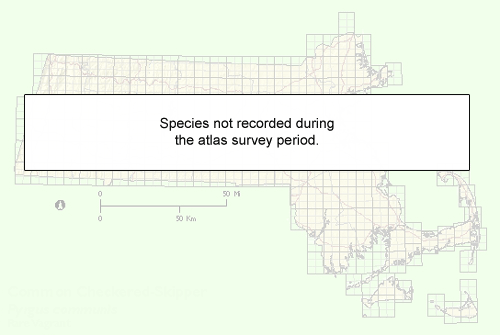Find a Butterfly
Sachem
Atalopedes campestris
Named
Boisduval , 1852
Identification
Wingspan: 1 3/8 to 1 5/8." Both sexes distinctive. Male Sachems are readily identified by the large, square, dark stigmal patch on the upper surface of the forewing. Females are variable in color from tan to dark brown and are best identified by the pattern of spots on the forewing above, especially the prominent square, transparent spot at the end of the forewing cell.
Distribution
Resident in the southeastern states south through Mexico and Central America to Brazil. Summer colonizers regularly range north through most of the lower 48 (excluding the Great Basin) from California east to New Jersey. In southernmost New Jersey the Sachem is rare in spring and summer, but common to abundant in fall (Schweitzer, pers. comm.). However above 40 degrees N., the species becomes rare and erratic; still considered a stray in the New York City/Long Island area, where "not recorded for many years at a time," Glassberg (1993). Layberry et al (1998) note that, following the large migration that reached southwestern Ontario in June 1988, the species bred at Pt. Pelee, and produced a second generation in August (Worthington, 1989).
Status in Massachusetts
Vagrant from the South. Four 1995 records, all females. One specimen: 1 July 1995, W. Tisbury, Martha‘s Vineyard (Dukes Co.), P. Miliotis. Three sight records: 4 July 1995, Chilmark Martha‘s Vineyard, A. Keith; 8 August 1995, World‘s End Reservation, Hingham (Plymourth Co.), T. Wright and B. Cassie and October 1995, Sudbury, (Middlesex Co.), T. Dodd. Pavulaan (pers. comm.) notes that these first New England records occured in the second year of a two year population explosion in the South: "Population numbers in Maryland and Virginia swelled each season, producing record numbers... swarming behavior noted in fields and suburban gardens...movement through Philadelphia observed in August...toward Northeast"

Flight Period in Massachusetts
Information for this species in Massachusetts is currently unavailable.
Larval Food Plants
Grasses, including the abundant weed grasses, Bermuda Grass (Cynodon dactylon) and Crabgrass (Digitaria sanguinalis).
Adult Food sources
Information for this species in Massachusetts is currently unavailable.
Habitat
Visits a variety of open, often disturbed areas including wasteplaces, fields, railroad track beds, and urban lots.
Life Cycle
Information for this species in Massachusetts is currently unavailable.
Account Author
Chris Leahy



